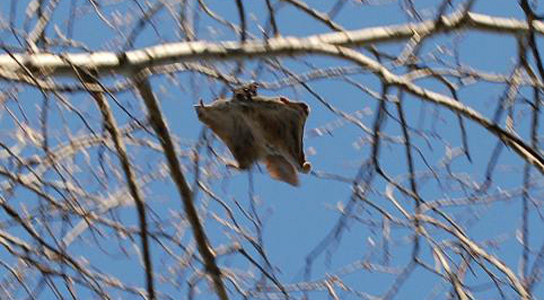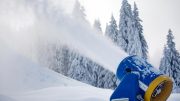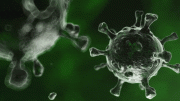
Flying squirrels can actively control their flight speed and direction by manipulating the furry membrane between their wrists and ankles. Credit: Angie spuc/Wikicommons
Flying squirrels, a tribe of 44 species of the family Sciuridae, might look reckless as they fling themselves through the air, but scientists have reported that there is a certain measure of finesse involved. The squirrels are able to actively manipulate the furry membrane that stretches between their wrists and ankles to control the speed and direction of their flight.
The scientists published their findings in the Journal of the Royal Society Interface. Flying squirrels, Pteromyini, aren’t capable of powered flight. Instead, they glide between trees, and are capable of obtaining lift whilst gliding. The flights can be up to 90 m. The direction and speed of the animal are changed by the positions of its two arms and legs, largely controlled by small cartilaginous wrist bones. The fluffy tail stabilizes the flight and acts as an adjunct airfoil, even working as an air brake when landing on a tree trunk.
The scientists set up video cameras in a Maine forest and analyzed the recordings of the animals lured to a feeder. Their glide-path trajectories were compared with aerodynamic simulations. Rather than cruising through the air at constant speeds, the squirrels continuously modulated their speed and direction to attain distance and lift. This contradicts aerodynamic models of the evolution of flight, which assumes that a transition from gliding to flapping would be too mechanically awkward and unstable.
The squirrels have the sensitivity and physical ability to adjust their membranes to fly more precisely. This could indicate that gliders may have indeed been the evolutionary precursors to creatures that flap, like bats and birds.
Reference: “Glide performance and aerodynamics of non-equilibrium glides in northern flying squirrels (Glaucomys sabrinus)” by Joseph W. Bahlman, Sharon M. Swartz, Daniel K. Riskin and Kenneth S. Breuer, 6 March 2013, Journal of the Royal Society Interface.
DOI: 10.1098/rsif.2012.0794









Be the first to comment on "Flying Squirrels Can Adjust Speed and Flight Dynamically"